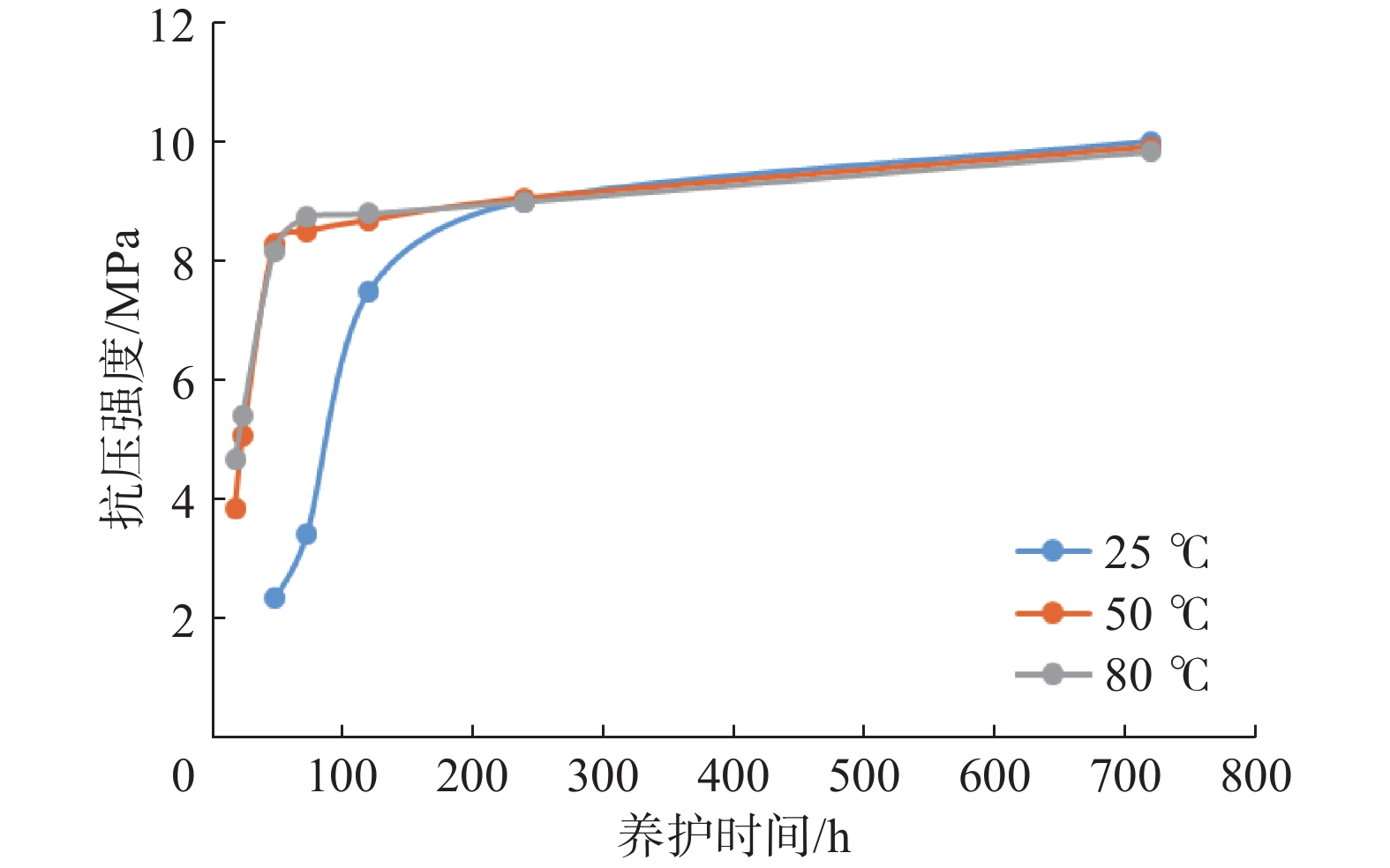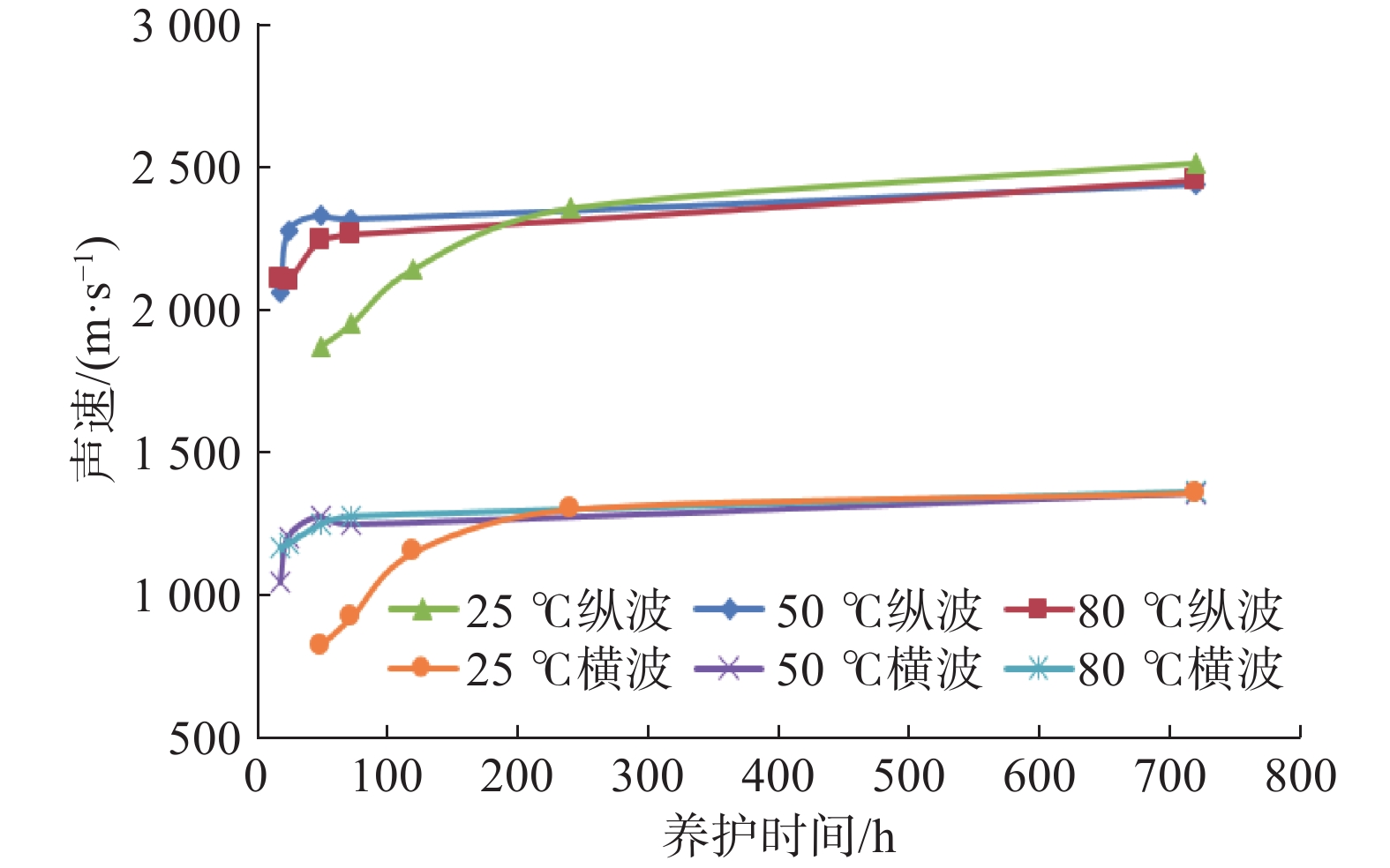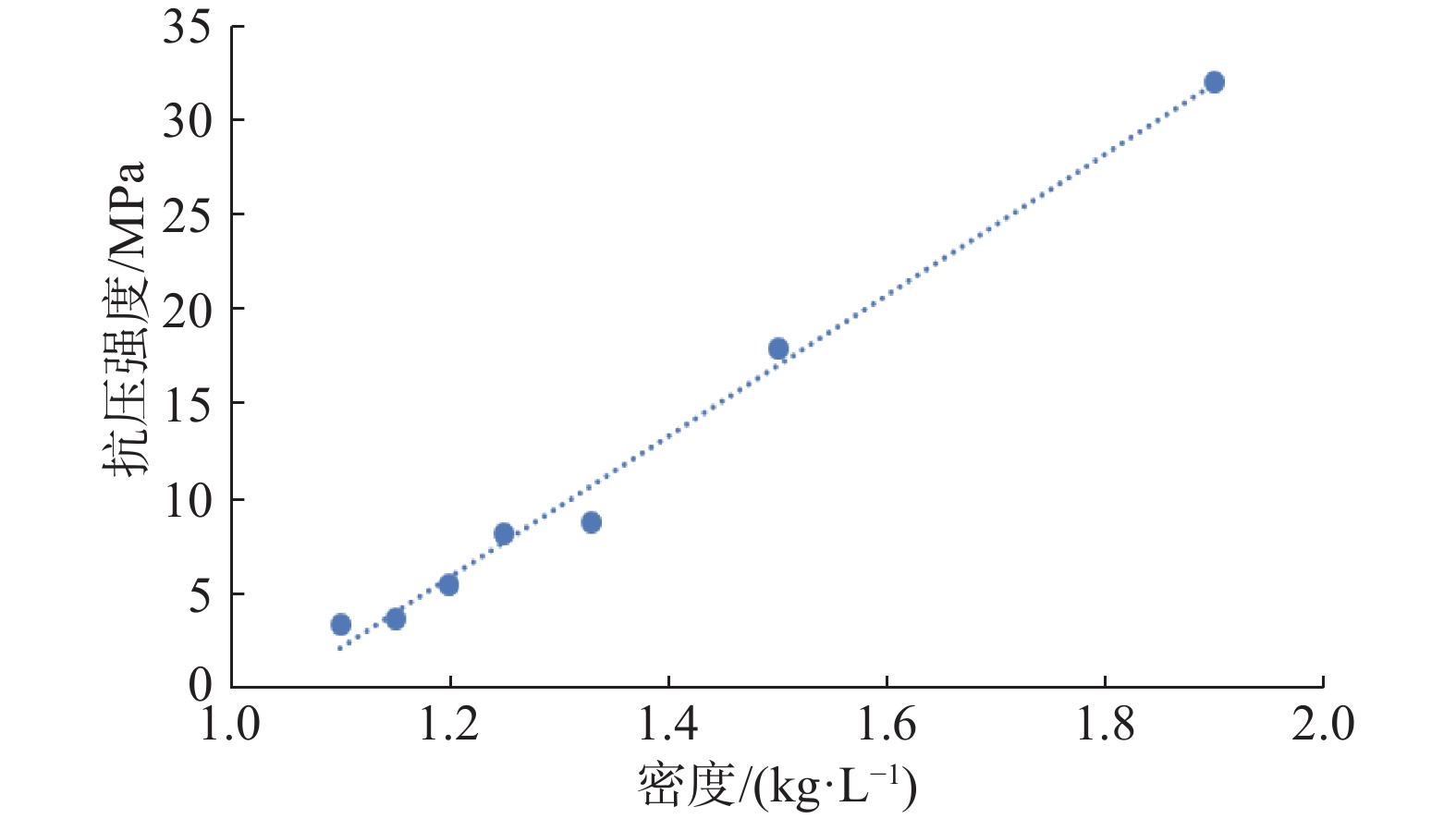Evaluation Method for Cementing Quality of Ultra-Low-Density Cement
-
摘要: 为了准确评价超低密度水泥浆固井质量,采用室内试验方法,研究了养护时间、温度和密度等参数对超低密度水泥石强度和声学特性的影响规律,拟合得到不同密度水泥石抗压强度与纵波、横波声速之间的关系方程;结合套管井井下声场分析结果,构建了基于抗压强度的超低密度水泥测井评价相对声幅改进算法,并建立了基于抗压强度的相对声幅校核图版。验证结果表明,漂珠类超低密度水泥石的相对声幅与抗压强度之间的对应关系较好,随着抗压强度增加,相对声幅减小;在相同抗压强度条件下,相对声幅随着水泥浆密度升高而减小。研究表明,应用超低密度水泥浆固井质量评价相对声幅校核图版,可以显著地提高固井质量评价的准确性和针对性。Abstract: For an accurate cementing quality evaluation of ultra-low-density cement slurry, an indoor experiment was carried out to study the influence of parameters such as curing time, temperature, and density on the strength and acoustic properties of ultra-low-density cement stone. The relationship equation between the compressive strength of cement stone with different density and the acoustic velocities of P-waves and S-waves was obtained by mathematical fitting. In combination with the downhole acoustic field analysis of cased wells, an improved algorithm of relative acoustic amplitude was developed for the evaluation of ultra-low-density cement slurry logging based on compressive strength, and a correction type-curve of relative acoustic amplitude was built on that basis. The verification results showed that for the cement slurry of cenospheres, the relative acoustic amplitude corresponded well to compressive strength, and with the increase in compressive strength, the relative acoustic amplitude decreased. Under the same compressive strength, the relative acoustic amplitude was reduced with the growth of cement slurry density. The research demonstrates that the application of the correction type-curve of relative acoustic amplitude for the cementing quality evaluation of ultra-low-density cement slurry can significantly improve the accuracy and pertinence of cemen-ting quality evaluation.
-
-
表 1 声学和强度特性试验用超低密度水泥浆配方
Table 1 Formula of ultra-low-density cement slurry for measurement of acoustic and strength properties
配方 密度/(kg·L−1) 水泥浆各成分含量,% G级水泥 漂珠1 漂珠2 微珠3 微硅 水 早强剂 降滤失剂 减阻剂 1 1.10 100 30 0 34 30 250 4.50 5.00 0.30 2 1.15 100 30 0 30 30 245 4.00 4.50 0.30 3 1.20 100 27 25 0 20 180 4.00 4.00 0.30 4 1.25 100 25 22 0 20 140 4.00 3.50 0.25 5 1.33 100 36 0 0 10 120 3.30 1.40 0.20 6 1.50 100 15 0 0 5 70 4.00 4.00 0.30 7 1.90 100 0 0 0 0 44 0 0.50 0.10 表 2 纵横波声速与抗压强度的拟合关系式
Table 2 Fitting relationship between compressive strength and acoustic velocity of P-waves and S-waves
序号 密度/(kg·L–1) 声波速度与抗压强度关系式 相关系数 1 1.10 p=0.002e0.0039vp R2=0.989 5 p=0.0019e0.0034vs R2=0.964 9 2 1.15 p=0.0055e0.0034vp R2=0.941 7 p=0.0145e0.0055vs R2=0.937 0 3 1.20 p=0.0019e0.0035vp R2=0.891 2 p=0.021e0.0045vs R2=0.860 7 4 1.25 p=0.0618e0.0021vp R2=0.920 6 p=0.0356e0.0041vs R2=0.955 4 5 1.33 p=0.0035e0.0034vp R2=0.900 6 p=0.0017e0.0067vs R2=0.911 3 -
[1] 陈雷,杨红歧,肖京男,等. 杭锦旗区块漂珠–氮气超低密度泡沫水泥固井技术[J]. 石油钻探技术,2018,46(3):34–38. CHEN Lei, YANG Hongqi, XIAO Jingnan, et al. Ultra-low density hollow microspheres-nitrogen foamed cementing technology in block Hangjinqi[J]. Petroleum Drilling Techniques, 2018, 46(3): 34–38.
[2] 杨海波,曹成章,冯德杰,等. 新型低密度水泥减轻材料SXJ-1的研制及应用[J]. 石油钻探技术,2017,45(4):59–64. YANG Haibo, CAO Chengzhang, FENG Dejie, et al. The development and application of a new low density cement reducer SXJ-1[J]. Petroleum Drilling Techniques, 2017, 45(4): 59–64.
[3] 李韶利. 1.15 g/cm3超低密度水泥浆的研究与应用[J]. 钻井液与完井液,2020,37(5):644–650. LI Shaoli. Study and application of an ultra-low-density cement slurry[J]. Drilling Fluid & Completion Fluid, 2020, 37(5): 644–650.
[4] 李早元,祁凌,刘锐,等. 空心微珠低密度水泥环完整性试验研究[J]. 石油钻探技术,2017,45(3):42–47. LI Zaoyuan, QI Ling, LIU Rui, et al. Experimental study on the integrity of low-density cement sheath with hollow microsphere[J]. Petroleum Drilling Techniques, 2017, 45(3): 42–47.
[5] 刘慧婷,付家文,丛谧,等. 高强度低密度水泥石的微观结构和力学性能[J]. 硅酸盐通报,2020,39(11):3432–3437. LIU Huiting, FU Jiawen, CONG Mi, et al. Microstructure and mechanical properties of high strength low-density cement[J]. Bulletin of the Chinese Ceramic Society, 2020, 39(11): 3432–3437.
[6] 李盛清,林剑松,江灿,等. 随钻声波测井固井质量评价理论与数值模拟研究[J]. 地球物理学报,2020,63(7):2762–2773. doi: 10.6038/cjg2020N0086 LI Shengqing, LIN Jiansong, JIANG Can, et al. Theoretical and numerical simulation of LWD acoustic cement logging[J]. Chinese Journal of Geophysics, 2020, 63(7): 2762–2773. doi: 10.6038/cjg2020N0086
[7] 韩耀图,李进,李疾翎,等. 超声兰姆波测井技术在渤海油田的应用研究[J]. 石油机械,2020,48(5):8–15. HAN Yaotu, LI Jin, LI Jiling, et al. Application of ultrasonic lamb wave logging technology in Bohai Oilfield[J]. China Petroleum Machinery, 2020, 48(5): 8–15.
[8] 张俊,夏宏南,孙清华,等. 几种固井质量评价测井方法分析[J]. 石油地质与工程,2008,22(5):121–123. doi: 10.3969/j.issn.1673-8217.2008.05.038 ZHANG Jun, XIA Hongnan, SUN Qinghua, et al. Analysis of several cement evaluation methods[J]. Petroleum Geology and Engineering, 2008, 22(5): 121–123. doi: 10.3969/j.issn.1673-8217.2008.05.038
[9] 李万东. 关于非泡沫超低密度水泥浆体系应用的建议[J]. 钻井液与完井液,2020,37(5):656–663. LI Wandong. Suggestions on application of non-foam ultra-low-density cement slurries[J]. Drilling Fluid & Completion Fluid, 2020, 37(5): 656–663.
[10] SY/T 6641—2017 固井水泥胶结测井资料处理及解释规范[S]. SY/T 6641—2017 Specification for logging data processing and interpreting of cement bond[S].
[11] SY/T 6592—2016 固井质量评价方法[S]. SY/T 6592—2016 Procedure for cement evaluation[S].
[12] SY/T 6466—2016 油井水泥石性能试验方法[S]. SY/T 6466—2016 Testing of set oilwell cement[S].
[13] 郑双进,程霖,龙震宇,等. 基于GA-SVR算法的顺北区块固井质量预测[J]. 石油钻采工艺,2021,43(4):467–473. ZHENG Shuangjin, CHENG Lin, LONG Zhenyu, et al. Predicting the cementing quality in Shunbei Block based on GA-SVR algorithm[J]. Oil Drilling & Production Technology, 2021, 43(4): 467–473.
[14] 步玉环,宋文宇,何英君,等. 低密度水泥浆固井质量评价方法探讨[J]. 石油钻探技术,2015,43(5):49–55. BU Yuhuan, SONG Wenyu, HE Yingjun, et al. Discussion of a method for evaluating cementing quality with low-density cement slurries[J]. Petroleum Drilling Techniques, 2015, 43(5): 49–55.
[15] 李早元,郑友志,郭小阳,等. 水泥浆性能对声波水泥胶结测井结果的影响[J]. 天然气工业,2008,28(7):60–62. doi: 10.3787/j.issn.1000-0976.2008.07.018 LI Zaoyuan, ZHENG Youzhi, GUO Xiaoyang, et al. Influence of cement slurry properties on acoustic cement bond log[J]. Natural Gas Industry, 2008, 28(7): 60–62. doi: 10.3787/j.issn.1000-0976.2008.07.018
[16] 罗勇,宋文宇,步玉环,等. 低密度水泥固井质量评价方法的改进[J]. 天然气工业,2012,32(10):59–62. doi: 10.3787/j.issn.1000-0976.2012.10.014 LUO Yong, SONG Wenyu, BU Yuhuan, et al. Improvement on the cementing quality assessment method for light-weight cement sheaths[J]. Natural Gas Industry, 2012, 32(10): 59–62. doi: 10.3787/j.issn.1000-0976.2012.10.014
-
期刊类型引用(13)
1. 李凯凯,安然,瞿春,王毅,贺红云. 超低渗透油藏暂堵压裂技术优化研究. 石油化工应用. 2023(11): 44-47+67 .  百度学术
百度学术
2. 张旺,吕永国,李忠宝,谢琳,邓建华. 绳结暂堵塞性能研究及现场应用. 中外能源. 2022(12): 63-69 .  百度学术
百度学术
3. 张笑言. 低产油气井强制裂缝转向重复压裂技术. 化学工程与装备. 2022(12): 123-124+138 .  百度学术
百度学术
4. 李德旗,朱炬辉,张俊成,石孝志,李军龙,邹清腾,张权,胡洋. 页岩气水平井选择性分簇压裂工艺先导性试验——以昭通国家级页岩气示范区为例. 天然气工业. 2021(S1): 133-137 .  百度学术
百度学术
5. 邴艳炜. 低产油气井重复压裂技术. 化学工程与装备. 2021(04): 143+120 .  百度学术
百度学术
6. 周丹,熊旭东,何军榜,董波,贺勇. 低渗透储层多级转向压裂技术. 石油钻探技术. 2020(01): 85-89 .  本站查看
本站查看
7. 李春月,房好青,牟建业,黄燕飞,胡文庭. 碳酸盐岩储层缝内暂堵转向压裂实验研究. 石油钻探技术. 2020(02): 88-92 .  本站查看
本站查看
8. 夏海帮. 页岩气井双暂堵压裂技术研究与现场试验. 石油钻探技术. 2020(03): 90-96 .  本站查看
本站查看
9. 蔡卓林,赵续荣,南荣丽,陈华生,李秀辉,梁天博. 暂堵转向结合高排量体积重复压裂技术. 断块油气田. 2020(05): 661-665 .  百度学术
百度学术
10. 孟祥灿. 大情字井油田A区块重复压裂增产技术. 油气井测试. 2020(05): 44-49 .  百度学术
百度学术
11. 郭睿,于瑾,毕青,李新发. 玉门油田深井重复压裂技术研究与应用. 中国石油和化工标准与质量. 2020(22): 190-191 .  百度学术
百度学术
12. 张子麟,陈勇,张全胜,李爱山,张潦源,李明,黄波. 致密砂砾岩压裂裂缝遇砾扩展模式的数值模拟研究. 油气地质与采收率. 2019(04): 132-138 .  百度学术
百度学术
13. 蒋建方,翟晓鹏,贺甲元,耿宇迪,崔佳,魏攀峰. 绒囊暂堵剂在深层碳酸盐岩储层转向压裂中的应用. 天然气工业. 2019(12): 81-87 .  百度学术
百度学术
其他类型引用(4)




 下载:
下载:












